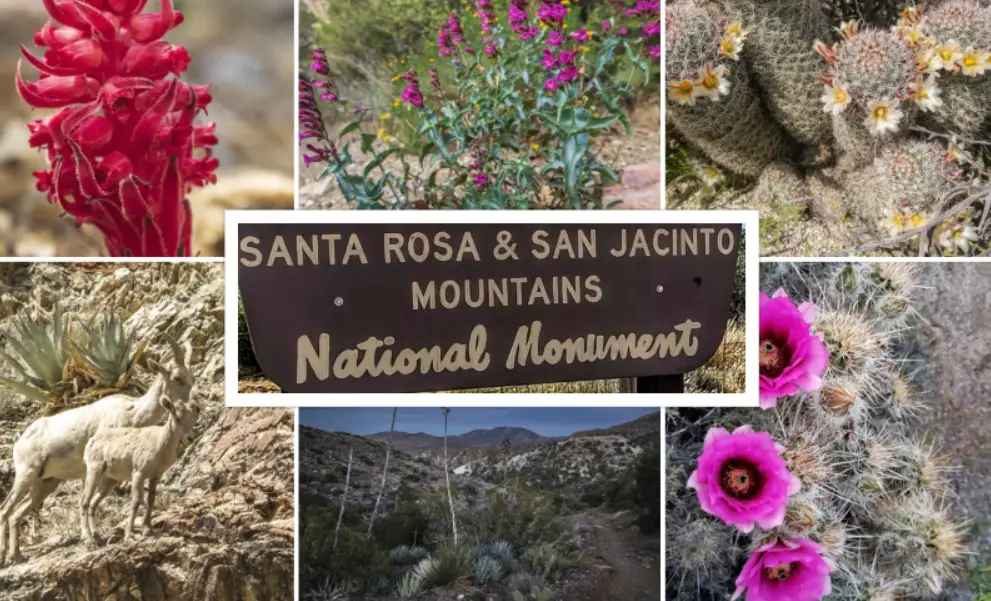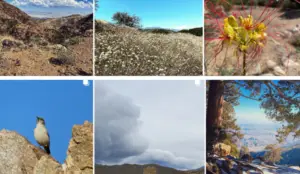Santa Rosa and San Jacinto Mountains : Interesting Facts, History & Travel Guide

- By
- Aparna Patel
- |
- 13 Apr, 2023
- |

The Santa Rosa and San Jacinto Mountains, located in Southern California, are a stunning natural wonder that offers a unique combination of desert and mountain landscapes. The range stretches over 130 miles and reaches heights of over 10,000 feet, making it one of the most impressive geological features in the area.
The Santa Rosa and San Jacinto Mountains are not only a breathtaking sight to behold, but they also hold a rich history and provide a plethora of recreational activities for visitors.
In this article, we will explore some interesting facts and history about the Santa Rosa and San Jacinto Mountains, as well as provide a travel guide for those looking to experience this incredible destination.
Table of Contents
Interesting facts about Santa Rosa and San Jacinto Mountains National Monument
- The monument is located in Southern California and encompasses more than 280,000 acres of land.
- The monument was established in 2000 by President Bill Clinton.
- The Santa Rosa and San Jacinto Mountains are part of the Peninsular Ranges, which extend from Southern California to Baja California, Mexico.
- The mountains within the monument reach heights of over 10,000 feet, making them some of the tallest in Southern California.
- The monument is home to a variety of plant and animal species, including the endangered Peninsular bighorn sheep.
- The area has a rich cultural history, with evidence of human habitation dating back over 2,000 years.
- The Cahuilla people, who have lived in the area for thousands of years, still consider the mountains within the monument to be sacred.
- The monument offers a range of recreational activities, including hiking, camping, rock climbing, and wildlife viewing.
- The monument is known for its unique geology, including the San Andreas Fault, which runs through the area.
- The Santa Rosa and San Jacinto Mountains National Monument is managed by the Bureau of Land Management, in partnership with the National Park Service and other agencies.
Santa Rosa Mountains camping
Camping in the Santa Rosa Mountains is a popular activity for visitors looking to experience the unique natural beauty of the area. There are several options for camping within the Santa Rosa Mountains, including both developed and primitive campsites.
One of the most popular campgrounds in the area is the Santa Rosa Campground, located in the Santa Rosa and San Jacinto Mountains National Monument. The campground offers 31 campsites with picnic tables, fire rings, and access to restrooms and drinking water. Reservations are recommended and can be made through the National Recreation Reservation Service.
For those who prefer a more primitive camping experience, dispersed camping is allowed in some areas of the national monument. Visitors are required to obtain a permit from the Bureau of Land Management and follow specific guidelines to ensure the protection of the natural resources.
It’s important to note that campfires are prohibited in the national monument due to the high risk of wildfires. Visitors are encouraged to bring a portable stove for cooking and to be mindful of their impact on the environment.
Overall, camping in the Santa Rosa Mountains is a fantastic way to experience the beauty and serenity of this unique landscape. With a variety of camping options available, there’s something for everyone, whether you’re a seasoned camper or a first-time visitor.
Santa Rosa Mountains elevation
The Santa Rosa Mountains are a range of mountains located in Southern California, USA. The highest point in the range is San Jacinto Peak, which has an elevation of 10,834 feet (3,302 meters) above sea level. The Santa Rosa Mountains have several other peaks that reach elevations over 8,000 feet (2,400 meters) and offer stunning panoramic views of the surrounding landscape.
The range is known for its unique combination of desert and mountain ecosystems and is home to a diverse array of plant and animal species. The Santa Rosa Mountains provide excellent opportunities for hiking, camping, and other outdoor activities, making it a popular destination for nature enthusiasts.
Santa Rosa Mountains Palm Springs
The Santa Rosa Mountains are located near the city of Palm Springs, which is a popular destination for tourists seeking sunshine, relaxation, and outdoor activities. Palm Springs is situated at the base of the Santa Rosa Mountains and is surrounded by stunning desert landscapes and towering peaks.
The Santa Rosa Mountains offer numerous opportunities for outdoor recreation, including hiking, rock climbing, camping, and wildlife watching. There are several trails in the area that provide access to the mountain range, ranging from easy walks to strenuous hikes for experienced hikers.
In addition to outdoor activities, Palm Springs is known for its hot springs, luxurious resorts, and vibrant arts and culture scene. Visitors can enjoy world-class dining, shopping, and entertainment options, as well as explore the rich history and architecture of the area.
Whether you’re looking to escape the hustle and bustle of city life, or seeking adventure in the great outdoors, the Santa Rosa Mountains and Palm Springs have something for everyone.
Information & History of Santa Rosa and San Jacinto Mountains National Monument
Santa Rosa and San Jacinto Mountains National Monument is a protected area located in Southern California, USA. It was established on October 24, 2000, by President Bill Clinton under the authority of the Antiquities Act. The monument spans over 280,000 acres and is managed by the Bureau of Land Management in partnership with other agencies, including the National Park Service.
The Santa Rosa and San Jacinto Mountains are part of the Peninsular Ranges, which run from Southern California to Baja California, Mexico. The mountains within the monument reach elevations of over 10,000 feet and are home to a variety of plant and animal species, including the endangered Peninsular bighorn sheep.
The area has a rich cultural history, with evidence of human habitation dating back over 2,000 years. The Cahuilla people, who have lived in the area for thousands of years, still consider the mountains within the monument to be sacred. The area also played a significant role in the early history of California, with Spanish explorers passing through the area in the 1700s.
The establishment of the monument was the result of years of efforts by local residents and conservation organizations, who recognized the ecological, cultural, and recreational value of the area. Today, the monument offers a range of recreational activities, including hiking, camping, rock climbing, and wildlife viewing. It also serves as an important research site, with ongoing scientific studies of the area’s geology, ecology, and cultural history.
Read More:
- Sand to Snow National Monument : Interesting Facts & Travel Guide
- San Juan Islands National Monument : Interesting Facts, History
- San Gabriel Mountains National Monument : Interesting Facts, History
- Salinas Pueblo Missions National Monument : Interesting Facts, History & Travel Guide
Travel Guide for Santa Rosa and San Jacinto Mountains National Monument
- When to visit: The best time to visit the monument is in the spring and fall, when temperatures are mild and the weather is pleasant. Summers can be hot, and winters can be chilly, so plan accordingly.
- Getting there: The closest airports are Palm Springs International Airport and Ontario International Airport. From there, you can rent a car and drive to the monument. The monument is accessible from several highways, including Interstate 10, Highway 74, and Highway 243.
- Things to do: The monument offers a range of recreational activities, including hiking, camping, rock climbing, and wildlife viewing. There are several hiking trails within the monument, ranging from easy to strenuous. The Palm Springs Aerial Tramway is also nearby and offers stunning views of the mountains.
- Where to stay: There are several campgrounds within the monument, including the Idyllwild Campground, Andreas Campground, and Black Mountain Group Campground. There are also several hotels and resorts in the nearby towns of Palm Springs and Palm Desert.
- What to bring: Be sure to bring plenty of water, sunscreen, and comfortable shoes for hiking. The weather can change quickly, so it’s also a good idea to bring layers and rain gear. Don’t forget your camera to capture the stunning views of the mountains.
- Respect the environment: When visiting the monument, it’s important to respect the environment and follow Leave No Trace principles. Pack out all trash and avoid disturbing wildlife or plants.
- Stay safe: Be aware of the potential dangers of hiking in the desert, including dehydration, heat exhaustion, and wildlife encounters. Always carry a map and stay on designated trails. Be sure to check for any trail closures or restrictions before heading out.
By following these tips, you can have a safe and enjoyable trip to Santa Rosa and San Jacinto Mountains National Monument.
Related Articles
- Salinas Pueblo Missions National Monument : Interesting Facts, History
- Russell Cave National Monument : Interesting Facts, History & Travel Guide
- Rose Atoll Marine National Monument : Interesting Facts, History
- Rainbow Bridge National Monument : Interesting Facts, History & Travel Guide
- President Lincoln and Soldiers’ Home : Interesting Facts, History
FAQ About Santa Rosa and San Jacinto Mountains National Monument
What is there to do at the monument?
The monument offers a range of recreational activities, including hiking, camping, rock climbing, and wildlife viewing. There are several hiking trails within the monument, ranging from easy to strenuous. The Palm Springs Aerial Tramway is also nearby and offers stunning views of the mountains.
When is the best time to visit the monument?
The best time to visit the monument is in the spring and fall, when temperatures are mild and the weather is pleasant. Summers can be hot, and winters can be chilly, so plan accordingly.
Are there camping facilities in the monument?
Yes, there are several campgrounds within the monument, including the Idyllwild Campground, Andreas Campground, and Black Mountain Group Campground.
What should I bring to the monument?
Be sure to bring plenty of water, sunscreen, and comfortable shoes for hiking. The weather can change quickly, so it’s also a good idea to bring layers and rain gear. Don’t forget your camera to capture the stunning views of the mountains.
Are there any restrictions or closures in the monument?
Yes, there may be trail closures or restrictions due to weather, fire danger, or other reasons. It’s important to check for any closures or restrictions before heading out on a hike.
What is the cultural significance of the monument?
The Santa Rosa and San Jacinto Mountains are part of the Peninsular Ranges, which have been inhabited by the Cahuilla people for thousands of years. The area also played a significant role in the early history of California, with Spanish explorers passing through the area in the 1700s. The monument is considered a sacred place by the Cahuilla people, and there are several cultural sites within the monument that are important to the tribe.
Search Posts
Latest posts
-
5 Mar, 2024
Passing through airport security with autism
-
4 Mar, 2024
Can I accidentally miss the in-flight food?